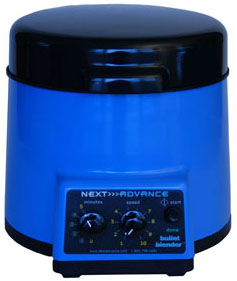Ideal for Nucleotide Extraction

Do you spend lots of time and effort homogenizing extracting nucleotide samples? The Bullet Blender® is a multi-sample homogenizer that delivers superior results. No other homogenizer comes close to delivering the Bullet Blender’s winning combination of top-quality performance and budget-friendly affordability.
The Bullet Blender® Homogenizer
Save Time, Effort and Get Superior Results
- Consistent and High Yield Results
Run up to 24 samples at the same time under microprocessor-controlled conditions, ensuring experimental reproducibility and high yield. Process samples from 10mg or less up to 3.5g. - No Cross Contamination
No part of the Bullet Blender® ever touches the samples – the sample tubes are kept closed during homogenization. There are no probes to clean between samples. - Samples Stay Cool
Homogenizing causes only a few degrees of heating. Our models come with a fan to maintain ambient temperatures. - Easy and Convenient to Use
Just place beads and buffer along with your sample in standard tubes, load tubes directly in the Bullet Blender, select time and speed, and press start. - Risk Free Purchase
The Bullet Blender® comes with a 30 day money back guarantee and a 2 year warranty, with a 3 year warranty on the motor. The simple, reliable design enables the Bullet Blenders to sell for a fraction of the price of ultrasonic or other agitation based instruments, yet provides an easier, quicker technique.

Bullet Blender settings for Nucleotide Extraction
Nucleotides can be extracted from almost any sample using the Bullet Blender. Explore our Protocols list to find the best protocol for your sample.
Selected publications for Nucleotide Extraction
2474232
DNA, RNA
1
apa
50
date
desc
3209
https://www.nextadvance.com/wp-content/plugins/zotpress/

